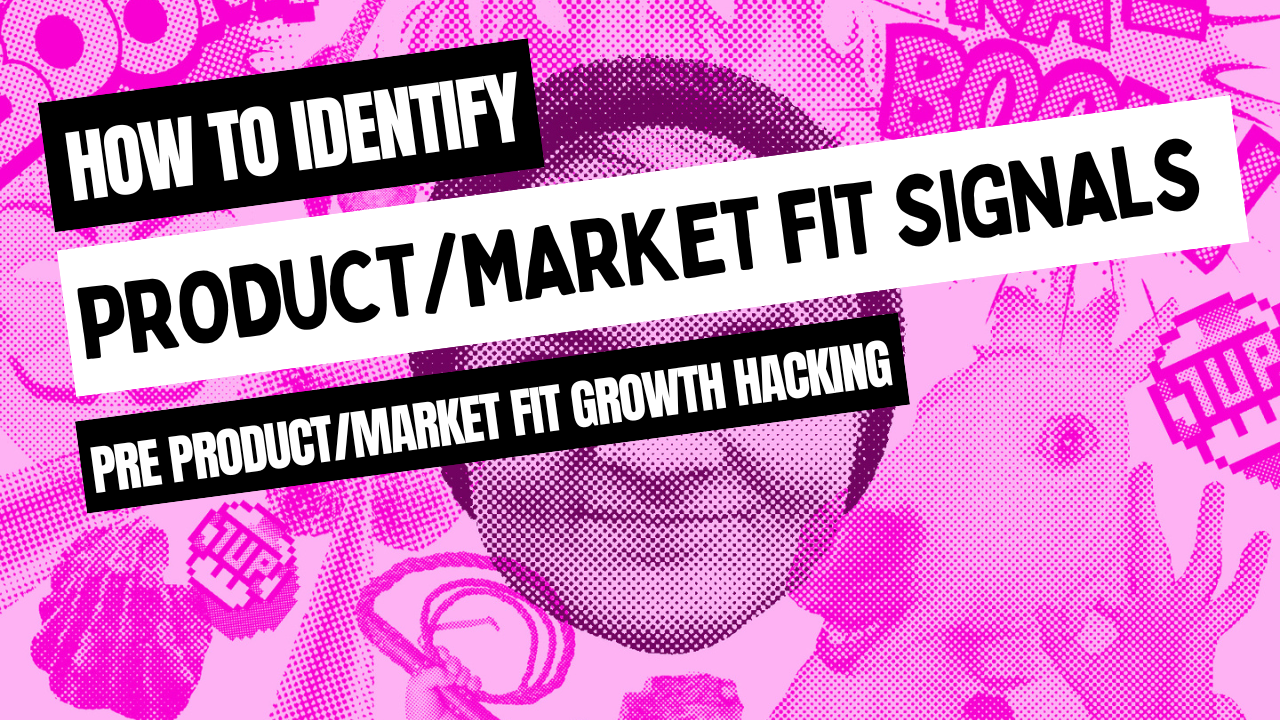How to identify product/market fit signals (pre product/market fit growth hacking)

Product/market fit is an important part of any sales funnel. Think of it as the moment when your customers essentially become your marketers or salesmen. Essentially, product/market fit is when your existing customers determine your product’s true value, so much so that they share their satisfactory experiences with your product with others. From there, your brand identifies what went right, so that those actions can be repeated for new customers.
Determining product/market fit can seem like a complex and difficult task. So much goes into determining if that fit is or is not there, and the testing for it can take a significant amount of time. It’s vital for teams to find the right growth hacking methods for finding product/market fit.
In this guide, we’ll dive into everything you need to know about early-stage product/market fit, as well as some excellent and cost-effective ways to test, learn, and identify the earliest signs of product/market fit.
Understanding product/market fit
Product/market fit is a scenario that occurs when a business’s value proposition, its customers, and its distribution channels finally sync. It’s the ultimate balance and when all three channels are aligned, long-term success can be expected.
There are a number of indicators of product/market fit, all of which depend on your unique industry and product use case. For the most part, though, it all comes down to how your customers are reacting to and consuming your product. For example, let’s say you’ve established some analytics methods for interviewing your customers. You’ve determined that about 45% of your existing customers would be very unhappy if your product suddenly disappeared from the market. That is an indicator of product/market fit, as you’ve created a “must-have” item in your industry. Another indicator of product/market fit is if your customers are buying your product faster than your manufacturers can physically produce them.
Understanding and identifying product/market fit can involve many different things (which we’ll dive into in the next section), but one big aspect of identifying it involves developing a customer profile, conducting customer interviews, and gathering ICP learnings.
“If you run your interviews correctly and people have fun you will no doubt get introductions to your next 2–3 interviews if you ask,” Dan Murphy noted in a writeup for Startup Frontier, “Lead velocity is the most critical part of this whole process, set a target of talking to 10 people [per] week… Listen, learn, adjust, and keep the conversations going. It’s invigorating. Make sure you have a script or process in mind before performing your interviews. [And] It’s important that you develop a way ahead of time to efficiently take notes during your interviews. The feedback you get from the people you talk to will help you improve your ICP and allow you to make tweaks in order to get closer to achieving product/market fit.”
To put it simply, you’ll have to take action and start having conversations. However, there are other ways to identify and test signals of product/market fit.
How to test, learn, and identify signals of product/market fit
Marc Andreessen, the founder of Netscape, recently spoke on being intuitive when it comes to product/market fit in an interview with Hackernoon.
“You can always feel when product/market fit isn’t happening,” Andreessen said in the interview, “The customers aren’t quite getting value out of the product, word of mouth isn’t spreading, usage isn’t growing that fast, press reviews are kind of ‘blah’, the sales cycle takes too long, and lots of deals never close. And you can always feel product/market fit when it’s happening. The customers are buying the product just as fast as you can make it — or usage is growing just as fast as you can add more servers. Money from customers is piling up in your company checking account. You’re hiring sales and customer support staff as fast as you can. Reporters are calling because they’ve heard about your hot new thing and they want to talk to you about it. You start getting entrepreneur of the year awards from Harvard Business School. Investment bankers are staking out your house. You could eat free for a year at Buck’s.”
Andreessen is right. It’s easy to tell when product/market fit is happening and when it is not. However, testing and learning about that fit is another story.
There are a number of cost-effective ways to test, learn, and identify the earliest signals of product/market fit. Measuring and documenting these signals can have a positive effect on your startup’s first funding round as well.
The test iteration process
Growth hacking is usually tied to the context of post product/market fit, but fundamentally you can use the test iteration process to accelerate identifying the product/market fit — even pre-funding to nail your pre-seed funding round. This process is simple and involves analyzing, hypothesizing, prioritize, and testing.
In a writeup for UX Collective, co-founder of Mahalle and COO of Phonepay Nima Torabi explained how to use iteration processes for testing MVPs and incorporating feedback.
“With the prototypes or MVP built, it becomes time for us to test the manifestation of all our assumptions and decisions related to the customer needs and priorities,” Nima Torabi said in the writeup, “With every user test, we gather feedback, make adjustments, or pivots to the offering design, improving on our ‘product-market fit’. This iterative process of testing MVPs and gathering market feedback can take quite a large amount of time, especially for a startup company. Startups could perform +20 iterations to their initial MVPs before witnessing sustained customer growth rates and engagement levels — so be patient. Unbiased customer interviews and UX testing will be major needed tools during this phase. For every testing phase, you will need 5–10 customers, before incorporating changes and testing with a new batch or sample. Make sure that you have metrics in place to track performance improvement upon the incorporation of customer feedback.”
Essentially, the test iteration process or iterative testing refers to the act of making relatively small and gradual updates to a product based on the insights you’ve gathered, such as user feedback and test results. From there, those small changes are then tested against predetermined baseline metrics. This is common in user experience testing, but it’s excellent for virtually any aspect of finding product/market fit in project management.
Put time into one-on-one interviews
There really isn’t a better way to understand what your customers want. It’s vital for a conversation to happen, and though this will be performed en masse, the individual conversations therein are very important. Talking to your users and customers will allow your team to identify problems, make a better product, increase brand awareness and trust, and create new ideas. It can also create a foundation for your startup’s initial ideas for customer segmentation.
Unfortunately, reaching out to customers directly can be difficult. It’s vital that your outreach team is alright with the uncomfortable nature of getting in touch with random customers and asking them for an introduction. However, a majority of customers will appreciate that your brand values their opinion and will provide that valuable information to be measured. Not only is this going to help with customer segmentation, but you’ll also be improving your brand awareness and trust factor — two things that are massively important in cementing your brand as an authority in your industry.
Customer interviews can be conducted via chat, in-person, or over the phone, though this will depend on what exactly you’re trying to discover in terms of product/market fit. Your interview questions should be very specific and very relevant to your unique product. As a general rule of thumb, your questions should involve the customer’s background (where they work, geographic location, other demographics, etc.) and what type of problem your customer is trying to solve by purchasing your product. Then, obviously, you’ll need to ask how they heard about your product, how they are using it, and if it is solving their problem.
Mike Fishbein has a massive list of customer development questions that can be very helpful for this process of finding product/market fit.
Find your value hypothesis before finding product/market fit
Value is at the heart of a good product/market fit. If a customer doesn’t find value in what your product offers, obviously your startup will not be able to last long. Determining the value that a customer gets from your product is, clearly, quite difficult to do, since value is a bit ambiguous in the context of product management.
This is where the value hypothesis comes in, which was originally pieced together by startup legends Steve Blank and Eric Ries.
You’ll have three things to consider: The pain point, the value hypothesis, and the product.
The pain point is the problem that your customers need to solve. Your product is, obviously, the product you want to make in order to solve that problem. The value hypothesis is a short prediction of how your product solves that problem and what the ultimate outcome could be. It essentially tests whether a product can really deliver value to your customers once they begin to use it. You can also incorporate a “growth hypothesis” that tests exactly how new customers are able to discover your product.
“Identifying a compelling value hypothesis is what I call finding product/market fit,” Wealthfront CEO Andy Rachleff told Fast Company in an interview on product/market fit, “A value hypothesis addresses both the features and business model required to entice a customer to buy your product.”
To put it simply, you should find your value hypothesis, give it a test run, and (if it ends up being correct) then you’ve found your product/market fit quite simply. In order to test a value hypothesis, you’ll need to give it a definition or a testable clear statement that can be validated or rebuked.
For example, let’s say you own a startup that provides content, particularly blog posts, to entrepreneurs and small business owners that want to operate 100% online.
Your pain point would be: Entrepreneurs don’t know how to move from brick-and-mortar stores to 100% e-commerce platforms.
Your value hypothesis would be: “XYZ Publication knows that startup owners need the kind of content that can help them launch and grow their businesses on the internet.”
Your product would be: The publication’s blog posts.
To test the above hypothesis, you would simply create content (your product) and monitor if people are talking about it, sharing it, reading it, interacting with it in the comments, etc. You could also take the interview approach and reach out to your online followers to see if your content is positively impacting them.
The value of measuring and documenting your product/market fit signals
It would be very wise to determine your value hypothesis and product/market fit before going through the process of finding venture money. Your value hypothesis essentially articulates the main assumption that causes a customer to use your product and addresses the features and business model necessary to get customers to buy your product. This is extremely valuable information for possible investors, and determining this before you start asking for startup money is very helpful.
Measuring and documenting your product/market fit signals can have a significantly positive effect on your startup’s first funding round. How else are you expected to show your stakeholders exactly what place your product has in the market? By testing and identifying different signals of product/market fit and keeping track of the results, you’re able to paint a very clear picture of the value your product has and why investors should consider funding your startup at an early level.
No spam, no sharing to third party. Only you and me.
